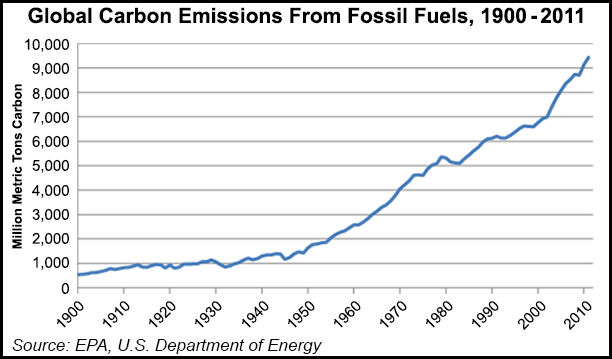Regulatory | NGI All News Access | NGI The Weekly Gas Market Report
EPA Draft Indicates Methane Emissions Rise Since 2013, Except for NatGas Transmission, Storage
The U.S. Environmental Protection Agency (EPA) on Monday issued a draft U.S. Inventory of Greenhouse Gas (GHG) Emissions, highlighting that methane emissions are higher than in 2013 but have fallen in natural gas transmission, distribution and storage systems.

The American Gas Association (AGA) provided a quick review of the draft and it was “mostly supportive” of the revisions.
At 9.3 million metric tons (mmt), the revised emission estimates by EPA for 2013 represent a 27% increase over previous estimates. Draft statistics show that methane emissions from transmission/storage declined by 47% to 1.2 mmt from 2.2 mmt, with distribution emissions down by 65% to 0.5 mmt from 1.3 mmt .
The bulk of the increases are in the midstream production/gathering sector, which rose 125% to 4.2 mmt from 1.9 mmt. Petroleum system emissions were 150% higher at 2.5 mmt from 1 mmt. The changes were prompted by an updated EPA accounting methodology.
The Interstate Natural Gas Association of America (INGAA) has been pushing EPA to update its GHG methodology in recent years, a Washington, DC-based spokesperson told NGI on Wednesday.
“Certainly, some of the reason for the lower numbers is the transmission/storage sector’s effort to tighten up the system to reduce releases,” but there are other factors too, the INGAA spokesperson said.
“EPA updated its estimation methods to reflect more recent data activity — compressor counts, for example — and more reasonable emission factors. These updates are intended to more accurately reflect current operations, while the last inventory still relied primarily on older data from the original 1990s EPA/Gas Research Institute study.”
INGAA officials noted that EPA is proposing to update estimates in the transmission/storage sector, such as station leaks and pneumatic device emissions based on activity data, emissions factors and last year’s Colorado State University study (see Daily GPI, July 22, 2015).
AGA’s Richard Meyer, who manages policy analysis, cited the findings from a study published last year that showed methane emissions from local gas distribution systems throughout the United States have decreased as much as 38-70% over the past 20 years (see Daily GPI, April 1, 2015).
“A lot of that work was incorporated into the methodology used by EPA as part of its revisions to the GHG emissions inventory for the distribution segment,” Meyer told NGI. Generally, the updated data “reflects increased investment in natural gas infrastructure, replacing aging cast iron and bare-steel pipe, along with meter and regulator station upgrades.” He said AGA supports the ongoing efforts to broaden the data to better reflect what is happening regarding methane emissions.
The Environmental Defense Fund (EDF), which has been heading a multi-phased national campaign to better identify and respond to methane leaks in the oil and gas industry, said EPA’s data support its claim that more needs to be done to curb emissions (see Shale Daily, Aug. 17, 2015).
EDF’s David Lyon said “there can be no more excuses for ignoring this huge challenge — not only controlling methane emissions from future sources, as proposed new EPA rules will do, but also controlling emissions from the tens of thousands of leaking facilities already operating now.”
An EDF spokesperson said 2013 emissions are now 27% higher at 9.3 mmt, and the EPA’s final numbers that are set to be released this spring “likely will be higher, based on improvements EPA has made to its current draft inventory.”
© 2024 Natural Gas Intelligence. All rights reserved.
ISSN © 1532-1231 | ISSN © 2577-9877 | ISSN © 1532-1266 |
